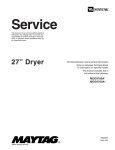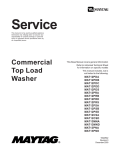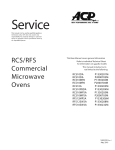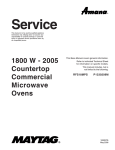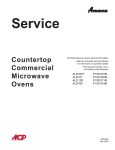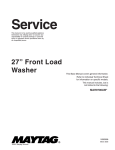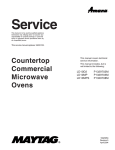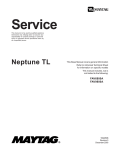Download Maytag FRONT-LOADING AUTOMATIC WASHER W10254495A Specifications
Transcript
Service This manual is to be used by qualified appliance technicians only. Maytag does not assume any responsibility for property damage or personal injury for improper service procedures done by an unqualified person. Compact Washer This Base Manual covers general information Refer to individual Technical Sheet for information on specific models This manual includes, but is not limited to the following: MAH2400AW* 16023430 Revision 0 ©2004 Maytag Services Important Information Important Notices for Technicians and Consumers Maytag will not be responsible for personal injury or property damage from improper service procedures. Pride and workmanship go into every product to provide our customers with quality products. It is possible, however, that during its lifetime a product may require service. Products should be serviced only by a qualified service technician who is familiar with the safety procedures required in the repair and who is equipped with the proper tools, parts, testing instruments and the appropriate service information. IT IS THE TECHNICIANS RESPONSIBILITY TO REVIEW ALL APPROPRIATE SERVICE INFORMATION BEFORE BEGINNING REPAIRS. ! WARNING To avoid risk of severe personal injury or death, disconnect power before working/servicing on appliance to avoid electrical shock. To locate an authorized technician, please consult your telephone book or the dealer from whom you purchased this product. For further assistance, please contact: Customer Service Support Center CAIR Center Web Site Telephone Number WWW.MAYTAG.COM ............................................. 1-800-688-9900 CAIR Center in Canada ........................................... 1-800-688-2002 Recognize Safety Symbols, Words, and Labels ! DANGER DANGER—Immediate hazards which WILL result in severe personal injury or death. ! WARNING WARNING—Hazards or unsafe practices which COULD result in severe personal injury or death. ! CAUTION CAUTION—Hazards or unsafe practices which COULD result in minor personal injury, product or property damage. 2 16023430 Rev. 0 ©2004 Maytag Services Table of Contents Important Information .................................................... 2 Important Safety Information ......................................... 4 General Information Model Identification .................................................... 8 Serial Label Location ................................................. 8 Model Nomenclature .................................................. 9 Model Specifications ................................................. 10 Troubleshooting Troubleshooting General Symptoms ......................... 11 Disassembly Procedures Top Removal ............................................................. 16 Water Valve Removal ................................................ 16 Pressure Valve Removal ........................................... 16 Drain Pump Removal ................................................ 17 EMI Filter Removal ................................................... 18 Console/Machine Control Board Removal ................. 18 Boot Removal ........................................................... 19 Door Assembly Removal ........................................... 19 Disassemble Door .................................................... 20 Front Panel/ Door Latch Removal .............................. 20 Motor and Belt Removal ............................................ 21 Tub Pulley Removal .................................................. 22 Tub Removal ............................................................. 22 Appendix A Installation Instructions ............................................. 27 Appendix B Use And Care ........................................................... 36 ©2004 Maytag Services 16023430 Rev. 0 3 Important Safety Information To reduce the risk of fire, electric shock, serious injury or death to persons when using your washer, follow these basic precautions: • Read all instructions before using the washer. • Refer to the Grounding Instructions in the Installation Manual for the proper grounding of the washer. • Do not wash articles that have been previously cleaned in, washed in, soaked in, or spotted with gasoline, dry-cleaning solvents, or other flammable or explosive substances as they give off vapors that could ignite or explode. • Do not add gasoline, dry-cleaning solvents, or other flammable or explosive substances to the wash water. These substances give off vapors that could ignite or explode. • Under certain conditions, hydrogen gas may be produced in a hot water system that has not been used for two weeks or more. Hydrogen gas is explosive. If the hot water system has not been used for such a period, before using a washing machine or combination washer-dryer, turn on all hot water faucets and let the water flow from each for several minutes. This will release any accumulated hydrogen gas. The gas is flammable, do not smoke or use an open flame during this time. • Do not allow children to play on or in the washer. Close supervision of children is necessary when the washer is used near children. This is a safety rule for all appliances. • Before the washer is removed from service or discarded, remove the lid to the washing compartment. • Do not reach into the washer if the wash tub is moving. • Do not install or store the washer where it will be exposed to water and/or weather. • Do not tamper with the controls. • Do not repair or replace any part of the washer, or attempt any servicing unless specifically recommended in the User-Maintenance instructions or in published user-repair instructions that you understand and have the skills to carry out. • To reduce the risk of an electric shock or fire, do not use an extension cord or an adapter to connect the washer to the electrical power source. • Use your washer only for its intended purpose, washing clothes. • Always disconnect the washer from electrical supply before attempting any service. Disconnect the power cord by grasping the plug, not the cord. • Install the washer according to the Installation Instructions. All connections for water, drain, electrical power and grounding must comply with local codes and be made by licensed personnel 4 16023430 • • • • • • • • • • • • when required. Do not do it yourself unless you know how! To reduce the risk of fire, clothes which have traces of any flammable substances such as vegetable oil, cooking oil, machine oil, flammable chemicals, thinner, etc. or anything containing wax or chemicals such as in mops and cleaning cloths, must not be put into the washer. These flammable substances may cause the fabric to catch on fire by itself. Do not use fabric softeners or products to eliminate static unless recommended by the manufacturer of the fabric softener or product. Keep your washer in good condition. Bumping or dropping the washer can damage safety features. If this occurs, have your washer checked by a qualified service person. Replace worn power cords and/or loose plugs. Be sure water connections have a shut-off valve and that fill hose connections are tight. Close the shut-off valves at the end of each wash day. Loading lid must be closed any time the washer is in operational fill, tumble, or spin. Do not attempt to bypass the loading lid switch by permitting the washer to operate with the loading lid open. Always read and follow manufacturer’s instructions on packages of laundry and cleaning aids. Heed all warnings or precautions. To reduce the risk of poisoning or chemical burns, keep them out of the reach of children at all times (preferably in a locked cabinet). Always follow the fabric care instructions supplied by the garment manufacturer. Never operate the washer with any guards and/or panels removed. Do not operate the washer with missing or broken parts. Do not bypass any safety devices. Failure to install, maintain, and/or operate this washer according to the manufacturer’s instructions may result in conditions which can produce bodily injury and/or property damage. NOTE: The Warnings and Important Safety Instructions appearing in this manual are not meant to cover all possible conditions and situations that may occur. Common sense, caution and care must be exercised when installing, maintaining, or operating the washer. Always contact your dealer, distributor, service agent or the manufacturer about any problems or conditions you do not understand. Rev. 0 ©2004 Maytag Services Important Safety Information To avoid personal injury or death from improper servicing, make sure you read and understand the descriptions and meaning of various safety symbols, words and labels used in this manual, before attempting any procedures described in the manual. Failure to understand and comply with safety information may result in severe personal injury or death. General Information This Service Manual describes the operation, disassembly, troubleshooting, and repair of the Compact washer. It is intended for use by authorized technicians who troubleshoot and repair these units. NOTE: It is assumed that users of this manual are familiar with the use of tools and equipment used to troubleshoot and repair electrical, and mechanical systems; and understand the terminology used to describe and discuss them. Related Publications This is a base service manual, covering a range of similar models. It is intended to be used in conjunction with the Parts Manual and Technical Sheet covering the specific model being serviced. Electrical Service Information Proper Grounding and Polarization of 120 Volts Wall Outlets For the safety of our customers and the Service Technician ALL appliances have a three–prong power cord and MUST be connected to a properly polarized AND grounded wall outlet. This information was written for those who do not understand grounding and polarization of a wall outlet. A 120 volt wall outlet must always be wired as shown below. Ground L1 Neutral side Round grounding prong ©2004 Maytag Services 115±12 V.A.C. About Ground Wires In the event of an electrical short circuit, a ground wire reduces the risk of electric shock by providing an escape wire for the electric current. Standard accepted color coding for ground wires is green or green with a yellow stripe. Grounding wires and wires colored like grounding wires are NOT to be used as current carrying conductors. To reduce the risk of fire, electric shock, serious injury or death, all wiring and grounding must conform with the latest edition of the National Electric Code, ANSI/ NFPA 70, or the Canadian Electrical Code, CSA C22.1, and such local regulations as might apply. It is the customer’s responsibility to have the wiring and fuses checked by a qualified electrician to make sure your home has adequate electrical power to operate the washer. To avoid risk of personal injury or death due to electrical shock: • • • • • • • • • • • Observe all local codes and ordinances. Disconnect electrical power to unit before servicing. Ground appliance properly. Check with a qualified electrician if you are not sure this appliance is properly grounded. DO NOT ground to gas line. DO NOT ground to cold water pipe if pipe is interrupted by plastic, nonmetallic gaskets, or other insulating (nonconducting) materials. DO NOT modify plug on power cord. If plug does not fit electrical outlet, have proper outlet installed by qualified electrician. DO NOT have a fuse in the neutral or ground circuit. A fuse in the neutral or ground circuit could result in an electrical shock. DO NOT use an extension cord with this appliance. DO NOT use an adapter plug with this appliance. DO NOT pinch power cord. Neutral 0 V.A.C. 115±12 V.A.C. 16023430 Rev. 0 5 Important Safety Information Explanation Polarization–This means that the larger slot must be neutral and the small slot must be at line voltage. Mispolarized–The outlet is incorrectly wired so that the larger slot is at line voltage and the smaller slot is neutral. Grounded–This means the round hole connection is connected to earth ground through a connection to the main power panel. Ungrounded–The round hole connection is not complete to earth ground and/or the main power panel. Grounding Instructions • To avoid the risk of electrical shock or death, do not alter the plug. • Do not remove grounding prong when installing grounded appliance in a home that does not have three wire grounding receptacle. Under no condition is grounding prong to be cut off or removed. It is the personal responsibility of the consumer to contact a qualified electrician and have properly grounded three prong wall receptacle installed in accordance with appropriate electrical codes. • To avoid the risk of electrical shock or death, this equipment must be grounded. This equipment MUST be grounded. In the event of an electrical short circuit, grounding reduces the risk of electric shock by providing an escape wire for the electric current. This unit is equipped with a cord having a grounding wire with a grounding plug. The plug must be plugged into an outlet that is properly installed and grounded. Consult a qualified electrician or technician if grounding instructions are not completely understood, or if doubt exists as to whether the equipment is properly grounded. Do not use an extension cord. If the product power cord is too short, have a qualified electrician install a three-slot receptacle. This unit should be plugged into a separate 60 hertz circuit with the electrical rating as shown in the appropriate drawing. Models operate with a supply voltage of 120 Volts. 6 16023430 Rev. 0 ©2004 Maytag Services Important Safety Information ©2004 Maytag Services 16023430 Rev. 0 7 General Information Service Model Identification Complete registration card and promptly return. If registration card is missing: • For Maytag product call 1-800-688-9900 or visit the Web Site at www.maytag.com • For product in Canada call 1-866-587-2002 or visit the Web Site at www.maytag.com. When contacting provide product information located on rating label. Record the following: Model Number: ___________________ Manufacturing Number: ___________________ Serial or S/N Number: ___________________ Date of purchase: ___________________ Dealer’s name and address: ___________________ Keep a copy of sales receipt for future reference or in case warranty service is required. To locate an authorized technician: • For Maytag call 1-800-462-9824 or visit the Web Site at www.maytag.com. • For product in Canada call 1-866-587-2002 or visit the Web Site at www.maytag.com. Warranty service must be performed by an authorized technician. We also recommend contacting an authorized technician, if service is required after warranty expires. Parts and Accessories Purchase replacement parts and accessories over the phone. To order accessories for your product call: • For Maytag product call 1-800-462-9824 or visit the Web Site at www.maytag.com. • For product in Canada call 1-866-587-2002 or visit the Web Site at www.maytag.com. Extended Service Plan We offer long-term service protection for this new washer. • Dependability PlusTM Extended Service Plan is specially designed to supplement Maytag’s strong warranty. This plan covers parts, labor, and travel charges. Call 1-800-925-2020 for information. Serial Label is located in the Lower side of the door opening and back panel. 8 16023430 Rev. 0 ©2004 Maytag Services General Information Compact Washer Nomenclature M A H 2 4 0 0 A Y W Color Brand W Q M= Maytag Product Type Listing W Y Z Y AH= Automatic Horizontal 120V-60hz 240V-60hz Canada 240V-60hz 220-240 V / 50-60 Hz Marketing Code Feature Content 2400 White Bisque This identifies which version of production the unit is. Feature Package Trouble Shooting and Diagnostic Guide is Located Behind Toe Panel. ©2004 Maytag Services 16023430 Rev. 0 9 General Information 10 16023430 Rev. 0 ©2004 Maytag Services Troubleshooting Procedures ! WARNING To avoid risk of electrical shock, personal injury or death, disconnect power to unit before servicing, unless testing requires power. Place washer into Service Mode and check for diagnostic codes. See Technical Data Sheet behind Toe Panel. Will Not Start • Plug cord into live electrical outlet. Check for proper voltage. • Check fuse or reset circuit breaker. • Push the START/PAUSE button to start the clothes washer. • Close door and push the START/PAUSE button to start the clothes washer. START/PAUSE LED should change from flashing to on continuously. • Check to see if the washer in a pause or soak period in the cycle. Wait briefly and it may start. • Check for restricted drain system. • Check the line filter connection terminals for good connections. • Check the Machine Control Board terminal connections. See Technical Sheet or Mini Manual packed inside washer. • Check for stuck buttons on Console, pushing in on board tact switches. Readjust buttons on inside of Console. • Replace Console Control Board. Leaking • Make sure inlet hose connections are not leaking. Check for rubber gasket damage due to overtightening. • Check standpipe for leak. Wrap a dry rag around the standpipe opening. If rag becomes wet, leak is fault of home plumbing. Be sure the standpipe is capable of accepting the flow of water from the washer. • Make sure end of drain hose is correctly inserted and secured to drain standpipe. • Check internal hose connections (fill, drain systems, dispenser hoses & clamps). • Check rubber boot. Remove, reposition and reinstall, if necessary. • Check for possible kinked dispenser to outer tub hose. Hot water pressurization may force door open. No Tumble • Start normal cycle with an empty machine and allow a fill to check tumble. • Fabric cycles such as NORMAL, DELICATES, HAND WASH, & WRINKLE CONTROL only tumble periodically, every 60 seconds. • Washer does not tumble during most fills or during presoak. • Perform Board Output Test. See Technical Sheet or Mini Manual packed behind Toe Panel. • Check for loose connections at Machine Control Board, Pressure Switch, Motor, Tach Harness and Motor Control. • Check motor windings resistance. (Connector CN1 Pins 8 & 9 = 3.6 ohms, pins 1 & 10 = 1.1 ohms, Pins 5 & 10 = 1.1 ohms) • Check belt. • Washer with heat option does not tumble while heating. (Export washers only) Will Not Spin • Check to make sure the door is fully closed. • Check for water left inside the washer. If present, see Will Not Drain. ©2004 Maytag Services • • • Perform Board Output Test. See Technical Sheet or Mini Manual packed behind Toe Panel. Will washer spin? Possible unbalanced load scenario previously. Check for loose connections at Machine Control Board, Pressure Switch, Motor, Tach Harness and Motor Control. Check belt. No Water Fill • Test water fill. Perform Board Output Test. See Technical Sheet or Mini Manual packed behind Toe Panel. • Check to make sure water supply is turned on fully. • With no clothes in washer normal water level is between the 4th and 5th hole on the spinner back wall. • Check electrical circuit and connections at the Water Valve, and Pressure Switch. • Check for kinks in inlet hoses. • Check for clogged inlet screens. • Visually check hot and cold separately for fill. • Check for low water pressure. May be dependent on pressure entering home. Variations may occur due to usage in the home at the time machine is used. • Check for frozen pipes and hoses. • Check resistance of water valve coils. (Normal 1.18K ohms; CN3 connector – Cold (BU) – Bleach (OR) – Hot (RD) and the White wire pin 1 on main. • Check for loose connections at the Pressure Switch or on the Machine Control Board, connector 5P. Tub Full of Suds • Check for restricted drain system. See Will Not Drain and Will Not Spin. • Check for loose wire connections at Control Board and Drain Pump. • Perform Board Output Test. See Technical Sheet or Mini Manual packed behind Toe Panel. • Use high efficiency or low sudsing detergent specially formulated for front load washers. • Reduce detergent amount for that specific load size and soil level. Towel loads have a minimal amount of soil present and typically create more suds. • Check to see if belt is off motor and pulley. • Run the clothes washer through another complete cycle using the coldest water, tablespoon of salt and no detergent. Wet Clothes • Very small clothes loads can cause unbalanced loads. Add additional towels. • Excessive suds may have been present, due to not using High-efficiency detergent. Reduce amount of detergent usage. • See Will Not Spin. • Low Spin Speed was selected. Will Not Lock • Door not all the way closed or not properly aligned. Possible laundry load is too large to close door. • Place washer into Service Mode and check for diagnostic codes 4 &18. See Technical Sheet or Mini 16023430 Rev. 0 11 Troubleshooting Procedures ! WARNING To avoid risk of electrical shock, personal injury or death, disconnect power to unit before servicing, unless testing requires power. • • Manual packed behind Toe Panel. Perform Board Output Test. Check door lock system. See Technical Sheet or Mini Manual packed behind Toe Panel. Check electrical connections at lock switch assembly and Machine Control Board (CN2). Will Not Unlock • Push door closed to make sure nothing from inside is pressing against it, which may keep it from unlocking. • Display shows LO. Press Off, Start/Pause or unplug washer. Door will unlock after 3 minutes. • Door locked from water level too high. Opening door will result in water draining from door opening. • Place washer into Service Mode. See Technical Sheet or Mini Manual packed behind Toe Panel. • Perform Board Output Test. See Technical Sheet or Mini Manual packed behind Toe Panel. Check door lock system for loose connections. Will Not Drain • Check for restricted drain system. • In cold climates check for frozen drain hose. • Check for 120 VAC at the Drain Pump when a spin cycle is selected. • Check pump motor winding resistance. (14.2 ohms) • Check that the machine control correctly senses the water level in the washer. See Board Input Test. See Technical Sheet or Mini Manual packed behind Toe Panel. • Go to Board Output Test and perform Pump out test. See Technical Sheet or Mini Manual packed behind Toe Panel. • Check the Machine Control Board connections at CN3 (Pin 1) for the pump and relay (Pin 2). • Should see 110-120VAC. • Check tub to pump hose for twist in hose. Wrong Water Temperature • Check that both faucets are turned on fully. • Make sure water heater is set to deliver a minimum of 120°F (49°C) hot water at the tap. Also check water heater capacity and recovery rate. • If the water heater is located a long distance from washer, the water line may need to be purged prior to starting wash cycle. • • • Too Hot/Too Cold: This washer uses a reduced amount of water, while the control board meters the incoming flow to regulate the actual temperature of the water in the tub. This may appear to be significantly warmer/cooler than expected. Make sure the temperature selection is correct. Disconnect inlet hoses from the Water Valve and clean the valve screens of any debris. Noisy and/or Vibration/Walking • • • • • Check if the washer was properly leveled and the locking nuts are securely tightened up against the base frame of the washer. Check and determine all five of the shipping bolts and spacers have been fully removed from the rear panel of the washer. Check for proper load size and distribution. If clothes load is too small, add a few towels to balance the clothes load better. Check the tightness of the rear pulley bolt. Tighten if necessary. Clean floor and bottom side of washer feet. Rubber Feet Leaving Marks on Floor • • Use a pencil eraser to remove mark. Walk washer into location, do not drag. Additive Cups Full of Water • • • Small amount of water in bottom of additive cups is normal. Remove and wash Dispenser Tray, removable Cup, and Rinse Cap. Level washer. Buttons do not Respond • • • Options cannot be changed while cycle is running. Press Start/Pause once to pause cycle while making selections. Press Start/Pause again to restart washer. Child Lock feature has been selected. To disable feature press and hold Chime and Delay Start simultaneously until a beep is heard. When display shows "End", only the Power Off button will function. Press Power Off and make new cycle selections. 2 1 12 16023430 Rev. 0 ©2004 Maytag Services Troubleshooting Procedures ! WARNING To avoid risk of electrical shock, personal injury or death, disconnect power to unit before servicing, unless testing requires power. Component Diagnostics NOTE: For ohm checks unplug harness connector on console and test from wire insertion side of the harness connectors. Main 5 4 3 2 1 DRAIN PUMP 1 Tub Sump Thermistor/ Pressure SW 2 4 3 2 1 CN3 CN4 Yellow wire Pin 3 on CN4 to Pink wire Pin 4 (5V+DC or approx 12,000 ohms) Blue wire Pin 2 on CN6 to Gray wire Pin 1 on CN3 120V or approx 16 ohms WATER VALVE 2 8 4 3 2 1 1 CN3 MAIN (Hot Valve) Red wire Pin 4 on CN3 to White wire Pin 1 on Main. Approx 11,000 ohms or 120 volts. (Bleach Valve) Orange wire Pin 3 on CN3 to Whitewire Pin 1 on Main. Approx 11,000 or 120 volts. (Cold Valve) Blue wire Pin 2 on CN3 to White wire Pin 1 on Main. Approx 11,000 ohms or 120 volts. ©2004 Maytag Services 16023430 Rev. 0 13 Troubleshooting Procedures ! WARNING To avoid risk of electrical shock, personal injury or death, disconnect power to unit before servicing, unless testing requires power. Motor windings 6 5 3 2 4 1 CN1 (CN1) Unplug connector and test Resistance at plug. Rotor Orange Pin 1 to Gray Pin 3 = approx 2.5 ohms); Stator Yellow Pin 5 to Violet Pin 4 = approx 1 ohms), Stator Yellow Pin 5 to Blue Pin 6 = approx 1 ohms) 1 3 2 4 5 6 78 9 10 Dispenser Circuit Water temperatures Non ATC Cold Wash and Rinse = tap temperature Non ATC Hot Wash = tap temperature ATC Cold Wash = 65 Degrees +/- 10 ATC Warm Wash = 105 Degrees +/- 10 ATC Warm Rinse = 80 Degrees +/- 10 for final rinse only, all others are tap cold 14 16023430 Rev. 0 ©2004 Maytag Services >> >> > >> >> > > > >> >> > >> >>>>>>>>> >> < << >>>>>>>> >>> << << >> > > > > > > >> > > > > >>>>>>>>>> >>> > < >>>> >>> >>> << >> << << >> >>> >>> >>>>>>>> > >>>>>>> >> >> >> >> >> >> >> > >> > >>>>>>>>>>>>>>>> > > < << << << >>>>>> >> >> >> >> >>>>>>>>> > >>>>>>>>>>>> >> >> >> > >> >> >> > > > > > >> >> > >> > > > >> >>>> >> > > >> > >> > >> > > > > > > > > > > > > > > > >> > > > > > >> > >> > > > >> >>>>>>>>>>> >>>>>>>>>>>> > > The two streams of cold water are designed to collide redirecting the path of the water to fill the softener reservior. >> >> >> > >>>>> >> >> >> > >>>>>>>>>>>> >>> >>>>>>> >> > >> > > > > >>> >> > >> >> >> > >> >> >> > >> >> >> << WARNING ! 15 16023430 Rev. 0 ©2004 Maytag Services >> > >> >>>>> >> <<< Troubleshooting Procedures To avoid risk of electrical shock, personal injury or death, disconnect power to unit before servicing, unless testing requires power. Fill Circuit Disassembly Procedures ! WARNING Top Removal To avoid risk of electrical shock, personal injury or death; disconnect power to unit before servicing. 4. Remove connectors. 1. Disconnect power supply to unit. 2. Remove 2 screws from washer back. 3. Slide Top Cover to the rear of the washer and separate from cabinet. 5. Remove screws retaining Water Valves. Pressure Valve Removal Water Valve Removal 1. Disconnect power supply to unit. 2. Remove Top Cover. 3. Remove hoses. 16 1. 2. 3. 4. Disconnect power supply to unit. Remove Top Cover. Remove Wiring connectors. Remove mounting screw. 16023430 Rev. 0 ©2004 Maytag Services Disassembly Procedures ! To avoid risk of electrical shock, personal injury or death; disconnect power to unit before servicing. WARNING Drain Pump Removal 1. Disconnect power supply to unit. 2. Gain access to bottom of unit. 3. Remove 4 screws securing panel to the bottom of the cabinet. 6. Remove 4 screws and slide pump mounting bracket to free tabs and remove motor. . 4. Remove drain hose and tub hose from pump. 5. Disconnect electrical connector . ©2004 Maytag Services 16023430 Rev. 0 17 Disassembly Procedures ! To avoid risk of electrical shock, personal injury or death; disconnect power to unit before servicing. WARNING EMI Filter Removal 1. Disconnect power supply to unit. 2. Remove Top Cover. 3. Remove wiring connectors and ground wires. 4. Tip Console to access connectors. NOTE: Clip wire ties if necessary to gain access to Control Board. Console/Machine Control Board Removal 1. Disconnect power supply to unit. 2. Remove Dispenser drawer. 3. Remove 2 screws located behind dispenser. Remove 1 screw on console right side. 18 CAUTION: Do not reassemble washer without replacing clipped wire ties. Do not remove wire ties if replacement are not available. 5. Remove connectors from Control Board back. 16023430 Rev. 0 ©2004 Maytag Services Disassembly Procedures ! To avoid risk of electrical shock, personal injury or death; disconnect power to unit before servicing. WARNING 6. Remove 5 screws retaining Control Board to Console. 3. Remove boot retainer wire from groove. 8. Separate the Control Board from the Console. 4. Pull boot over lip on Front Panel. Boot Removal 1. Disconnect power supply to unit. 2. Remove Boot retainer spring. Door Assembly Removal 1. Remove Door Hinge with screwdriver and 5/16” wrench. ©2004 Maytag Services 16023430 Rev. 0 19 Disassembly Procedures ! WARNING Disassemble Door Assembly To avoid risk of electrical shock, personal injury or death; disconnect power to unit before servicing. 6. Remove glass sight window from frame. 1. Disconnect power supply to unit. 2. Remove Door Assembly 3. Remove screws on door inner panel. NOTE: Align indent in glass with drain hole in frame during reassembly. 4. Remove pin through door strike. Front Panel/ Door Latch Removal 1. Disconnect power supply to unit. 2. Remove Console. 3. Remove Toe Panel. 5. Unsnap handle from retainer. 4. Remove 3 screws on Front Panel bottom. 20 16023430 Rev. 0 ©2004 Maytag Services Disassembly Procedures ! To avoid risk of electrical shock, personal injury or death; disconnect power to unit before servicing. WARNING 5. Remove 6 screws on Front Panel top and bottom. 8. Remove 2 screws retaining Door Latch to Front Panel. Motor and Belt Removal 1. Disconnect power supply to unit. 2. Remove 3 screws retaining Back Cover. 6. Lift front Panel from hanger hooks. 3. Remove belt by pulling belt while rotating pulley causing belt to derail from motor. 7. Disconnect Door Latch wire connector. 4. Remove Motor wiring connector and ground wires. ©2004 Maytag Services 16023430 Rev. 0 21 Disassembly Procedures ! To avoid risk of electrical shock, personal injury or death; disconnect power to unit before servicing. WARNING 5. Remove Motor wiring connector and ground wires. 6. Remove 2 1/2” Motor mounting bolts. Bolt torque is 10.8-18.1 ft. lbs. 4. Insert a 3/8” drive extension into hole in bearing cover to lock pulley from rotating. 5. Loosen bolt retaining pulley. Bolt torque is 21.7-28.9 ft. lbs. Tub Removal 7. Swing Motor down and to the left to remove. 1. 2. 3. 4. 5. 6. 7. Disconnect power supply to unit. Remove Top Cover. Remove Back Cover. Disconnect and remove Drive Motor and belt. Disconnect Drain Pump hose and wiring. Remove Front Panel. Remove wire harness and hose from Pressure Switch. Remove the Pressure Hose from tub bottom. 8. Remove Console mounting bracket. Tub Pulley Removal 1. Disconnect power supply to unit. 2. Remove Back Cover. 3. Remove Belt. 22 16023430 Rev. 0 ©2004 Maytag Services Disassembly Procedures ! To avoid risk of electrical shock, personal injury or death; disconnect power to unit before servicing. WARNING 9. Remove Fill Hose and Dispenser Hose from Tub. 12. Remove Dispenser from washer. 13. Remove 1/2” bolts retaining upper counter weight. Bolt torque is 10.8 to 18.1 ft. lbs. 14. Remove Upper Counter Weight. 10.Remove Dispenser Feeder Hoses. 15. Disconnect Sump Thermistor wire harness. 11. Remove screw retaining Dispenser. 16.Remove 3 1/2” bolts retaining Lower Counter Weight. Bolt torque is 10.8 to 18.1 ft. lbs. ©2004 Maytag Services NOTE: Mark the counter weight front surface for ease of reassembly. 16023430 Rev. 0 23 Disassembly Procedures ! To avoid risk of electrical shock, personal injury or death; disconnect power to unit before servicing. WARNING 17.Remove Lower Counter Weight. 20.Move Struts to center of washer. 21.Mark location and position of Suspension Springs. 18.Remove remaining wire harnesses and hose from tub. 19.Remove 2 1/2” bolts retaining the Struts. All Strut bolts are torqued to 18.1-25.3 ft. lbs. 24 22.Reinstall Upper Counter Weight bolts to tub without weight in place. Use these as handles when lifting tub. 16023430 Rev. 0 ©2004 Maytag Services Disassembly Procedures ! To avoid risk of electrical shock, personal injury or death; disconnect power to unit before servicing. WARNING 23.Use weight bolts to lift tub and unhook Suspension Springs. 26. Remove rear Spinner Pulley. NOTE: After Spinner Pulley bolt is removed Spinner can fall from tub. Block Spinner to prevent Spinner from falling free. 27. Remove bolts around perimeter and separate the tub halves. 24.Grasp the front and rear of the tub and remove from cabinet. 25.Loosen screw and remove boot from tub lip. ©2004 Maytag Services NOTE: During reassembly snug bolts in a cross pattern before tightening to prevent tub warp. 28. Remove Spinner. 16023430 Rev. 0 25 Disassembly Procedures ! To avoid risk of electrical shock, personal injury or death; disconnect power to unit before servicing. WARNING 29.Install new Gasket between front and rear tub halves. 30.Install new Spinner and reassemble washer by reversing the preceding steps. 26 16023430 Rev. 0 ©2004 Maytag Services Appendix A ©2004 Maytag Services 16023430 Rev. 0 27 HIGH-EFFICIENCY WASHER INSTALLATION INSTRUCTIONS MACHINE À LAVER HAUTE EFFICACITÉ GUIDE DE MISE EN SERVICE INSTRUCCIONES PARA LA INSTALACIÓN DE LA LAVADORA DE ALTA EFICIENCIA LEAVE THESE INSTRUCTIONS WITH THE OWNER LAISSER CE GUIDE DE MISE EN SERVICE AU PROPRIÉTAIRE DEJAR ESTAS INSTRUCCIONES CON EL PROPIETARIO (7/28/04 Revision) (0623/04 28 16023430 Rev. 0 2201459 ©2004 Maytag Services READ THIS BEFORE YOU START… ELECTRICAL Tools needed for installation: Refer to serial plate for specific electrical requirements. For more detailed information refer to section on Electrical Requirements. • Multi wrench • Utility knife • Channel lock • Level WATER Washer needs two standard 3/4 inch water supply faucets with a pressure between 20–120 pounds per square inch. For more detailed information refer to section on Water Requirements. PARTS supplied for installation: Cable tie to secure drain hose to standpipe, inlet hose or laundry tub CABINET DIMENSIONS WASHER DIMENSIONS A. Height – Overall* B. Depth to Front of Control Dial C. Width D. Depth – With Washer Door Open 90° E. Depth INCH (CM) 33.25” (84.5) 26” (66.1) 23.5” (59.7) 41.25” (104.3) 24” (60.9) E Note: The height of the washer from top to floor is 33 1\4" this includes the leveling leg screwed all the way in. The customer can unscrew the leg out an additional 7\8" for a total overall height of 34 1\8". 2 ©2004 Maytag Services 16023430 Rev. 0 29 BASIC LOCATION REQUIREMENTS: ELECTRICAL • • • 120 Volt 60 Hz 15 AMP Fuse or Circuit Breaker Individual branch circuit serving only the washer is recommended. The washer is equipped with a power cord. NEVER USE AN EXTENSION CORD. GROUNDING ELECTRICAL GROUND IS REQUIRED ON THIS APPLIANCE. Appliance is equipped with a power cord having a 3-prong grounding plug for use in a properly installed and grounded outlet. ! WARNING • Improper connection of the equipment-grounding conductor can result in a risk of electrical shock. Check with a qualified electrician or serviceman if you are in doubt as to whether the appliance is properly grounded. Do not modify the plug provided with the appliance – if it will not fit the outlet, have a proper outlet installed by a qualified electrician. IMPORTANT SAFETY PRECAUTIONS • To prevent unnecessary risk of fire, electrical shock or personal injury, all wiring and grounding must be done in accordance with the National Electrical Code ANSI/FNPA, No. 70-Latest Revision and local codes and ordinances. It is the personal responsibility and obligation of the appliance owner to provide adequate electrical service for this appliance. ADDITIONAL GROUNDING CONNECTIONS A grounding kit (Part No. 12001875) is available. It contains the ground wire, clamp, ground screw and washer. Connect the ground wire to back of unit with the cabinet ground screw and washer. Secure the other end of ground wire to a grounded COLD metal water pipe. NEVER CONNECT GROUND WIRE TO PLASTIC PLUMBING LINES, GAS LINES OR HOT WATER PIPES. WATER To correctly fill the washer in the proper amount of time, Water pressure of 20 to 120 p.s.i. is required. Water pressure less than 20 psi may cause a failure in the water valve and may not allow the water valve to shut off completely. Or may extend the fill time beyond what the washer controls will normally allow and result in the washer turning off. A time limit is built into the controls in the event of an internal hose becoming loose and avoids a flooded home. The water valve Hot and Cold water faucets must be within 4 feet of the back of the washer for inlet hoses provided with the washer. NOTE: Accessory inlet hoses are available in various lengths up to 10 feet for faucets more than 4 feet from the back of the washer. 30 16023430 Rev. 0 ©2004 Maytag Services To Avoid The Possibility Of Water Damage: • • Have Water Faucets Easily Accessible Turn Off Faucets When Washer Is Not In Use. DRAIN FACILITY Recommended height of the standpipe is 18”. The drain hose must be routed through the drain hose clip to the standpipe. Standpipe must be large enough to accept the outside diameter of the drain hose. The drain hose is attached at the factory. FLOORING For best performance the washer must be installed on a solidly constructed floor. Wood floors may need to be reinforced to minimize vibration and/or unbalanced load situations. Carpeting and soft tile surfaces are contributing factors in vibration and/or tendency for a washer to move slightly during the spin cycle. Never install the washer on a platform or weakly supported structure. LOCATION CONSIDERATIONS It is recommended the washer never be installed in areas where water may freeze since the washer will always maintain some water in the water valve, pump and hose areas. This can cause damage to belts, pump, hoses and other components. Operating temperature should be above 60 °F. ALCOVE OR CLOSET INSTALLATION MINIMUM CLEARANCES FOR CLOSET AND ALCOVE INSTALLATIONS: 0 in / 250 mm Sides – 0 in / 0 mm Rear – 1 0 mm Closet Front – 0 in / 0 mm Top – 0 2 in / 51 The closet front must have a total unobstructed air opening of 72 in 2. / 465 cm 2 minimum, if both washer and dryer are installed together. A louvered door with equivalent air opening is acceptable. Washer alone does not require specific air opening. UNDERCOUNTER INSTALLATION MINIMUM CLEARANCES FOR UNDERCOUNTER INSTALLATIONS: Sides – 0 in / 0 mm Rear – 0 in / 0 mm Top – 0 in / 0 mm Front – 0 in / 0 mm 33 1/4" - 34 1/8" 26” m in. ” 23 1/2 ©2004 Maytag Services 16023430 Rev. 0 31 32 16023430 Rev. 0 ©2004 Maytag Services ©2004 Maytag Services 16023430 Rev. 0 33 34 16023430 Rev. 0 ©2004 Maytag Services ©2004 Maytag Services 16023430 Rev. 0 35 Appendix B 36 16023430 Rev. 0 ©2004 Maytag Services ©2004 Maytag Services 16023430 Rev. 0 37 38 16023430 Rev. 0 ©2004 Maytag Services ©2004 Maytag Services 16023430 Rev. 0 39 40 16023430 Rev. 0 ©2004 Maytag Services ©2004 Maytag Services 16023430 Rev. 0 41 42 16023430 Rev. 0 ©2004 Maytag Services ©2004 Maytag Services 16023430 Rev. 0 43 44 16023430 Rev. 0 ©2004 Maytag Services ©2004 Maytag Services 16023430 Rev. 0 45 46 16023430 Rev. 0 ©2004 Maytag Services ©2004 Maytag Services 16023430 Rev. 0 47 48 16023430 Rev. 0 ©2004 Maytag Services ©2004 Maytag Services 16023430 Rev. 0 49 50 16023430 Rev. 0 ©2004 Maytag Services ©2004 Maytag Services 16023430 Rev. 0 51 52 16023430 Rev. 0 ©2004 Maytag Services




















































